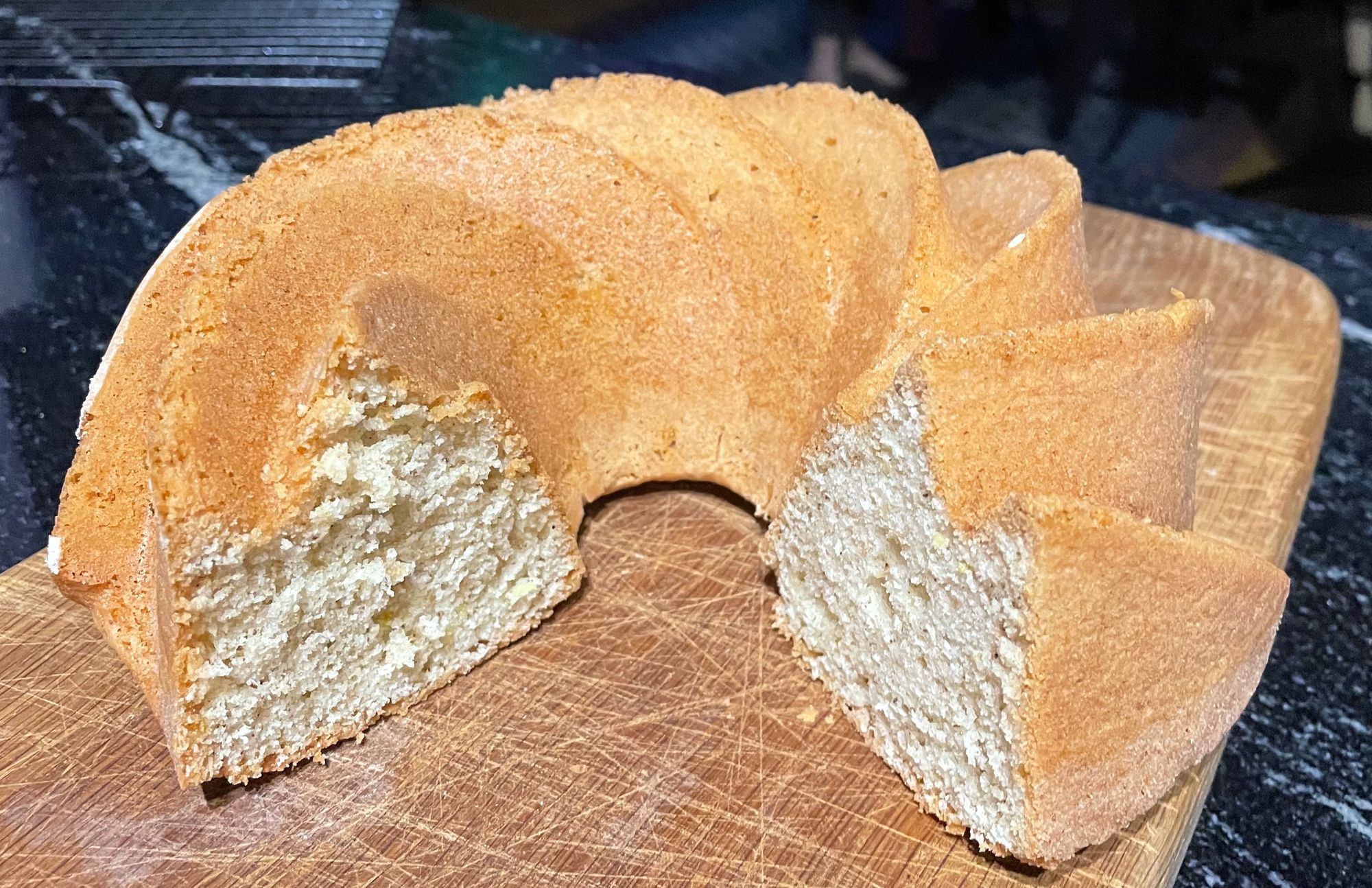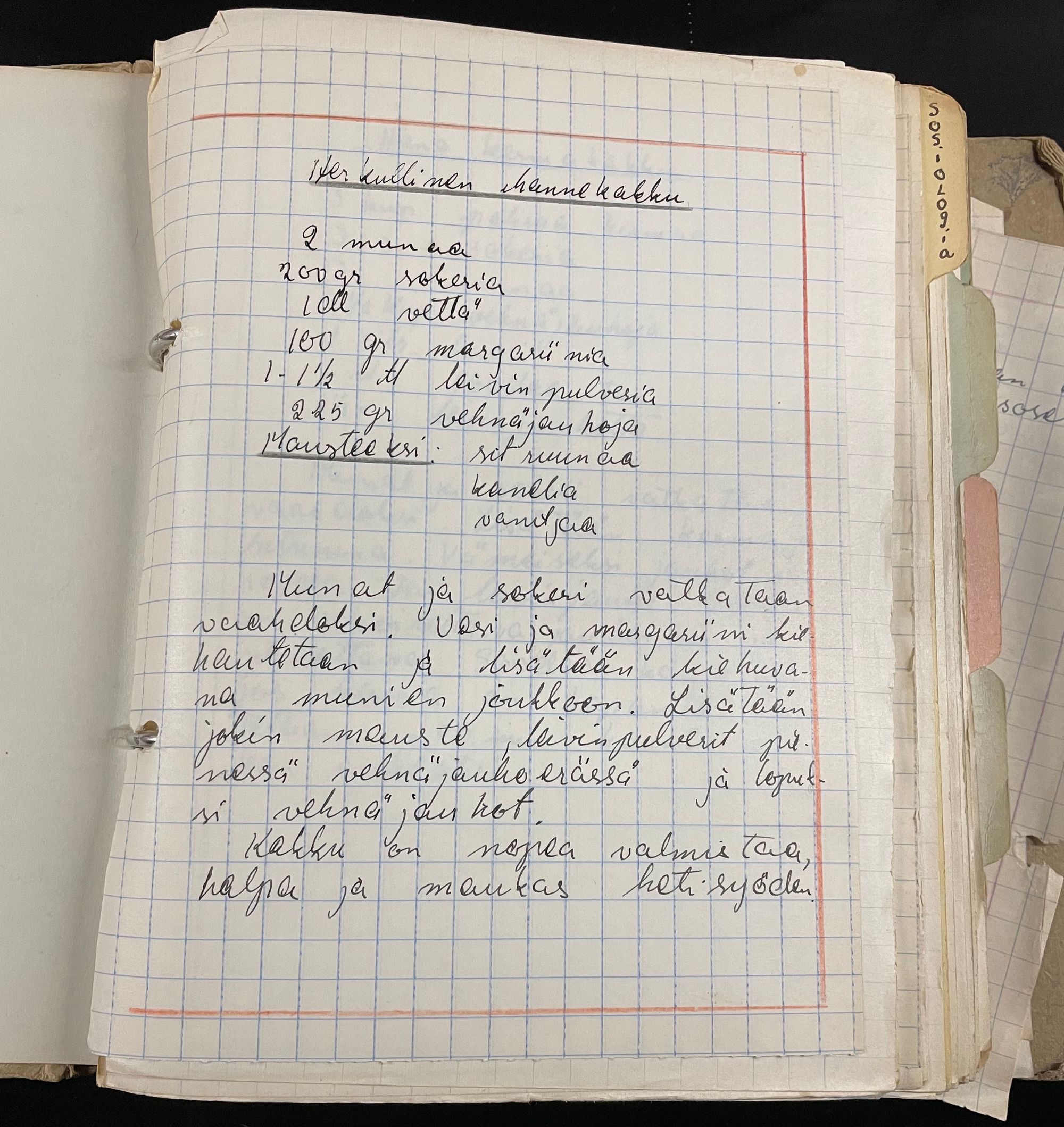Ihannekakku, or the Ideal Cake

Äidin Resepti
Ainokset:
- 2 munaa
- 200 gr sokeria
- 1 dl vettä
- 100 gr margariinia
- 1-1.5 tl leivinpulveria
- 225 gr vehnäjauhoja
- Mausteeksi: Sitruunaa, kanelia, vaniljaa
Ohjeet:
Munat ja sokeri veikkataan vaaheloksi. Vesi ja margariini(voi) kiehautetaan ja lisätään kiehuvana munien joukkoon. Lisätään jokin mauste, leivinpulverit pienessä vehnäjauhoerässä ja loputsi vehnäjauhot.
Kakku on nopea valmistaa, halpa ja maukas. Heti syöden.
Mom's Recipe
Ingredients:
- 2 eggs
- 200 g sugar
- 1 dl water
- 100 g margarine
- 1-1.5 tsp baking powder
- 225 g wheat flour
- Flavourings: Lemon, cinnamon, vanilla
Instructions:
Cream together the eggs and sugar. Bring the water and margarine to a boil and add to the eggs. Add your chosen flavourings, the baking powder as well as a small portion of the wheat flour to the wet mixture. Finally, add the remaining wheat flour.
The cake is quick to make, cheap and tasty. To be eaten immediately.
Personal adjustments and additions
- Butter, instead of margarine. Always.
- Baked at 175 degrees C, 50 minutes or until the dough separated from the mold.
- I treated the inside of the bunt cake form with oil and flour so that the cake came out easily. In Finland I brushed on "juokseva rypsyöljyvalmiste" but in the US I would have used a spray oil like Pam or something similar. This is to get it in to all the nooks and crannies on the form, otherwise the cake doesn't look as nice. As you can see from the pictures, my first time I just rubbed in butter but that didn't get in to all the corners nicely.
- Flavorings: The first time I made the cake I didn't have lemon, so I tried a combo of the zest of one lime, 1.5 tbsp ground coconut and 1/2 tsp cinnamon. It mostly just tasted of coconut, but there were hints of the other two. My second attempt I used the zest of one lemon, 1 tsp cinnamon and 1 tsp vanilla sugar, and it was pretty good all around. Vanilla sugar can be substituted 1 for 1 with vanilla extract.
When we moved to Finland from the US, one of the things that I discovered is that the type and availability of ingredients in stores is sometimes surprising. Vanilla and vanillin sugar are easy to find, whereas vanilla extract is a specialty item. The categorization of flours is entirely different. Spices like cumin, cardamom, and coriander seed are sold in their ground form, but are only found whole in specialty stores.
In practice, this meant that recipes intended for use in the US (where the ingredients would be easy to find at any store) now had to be converted. The more I ran in to this, the more I thought I should just undergo a process of making "simple" Finnish foods so that I could better understand the resources as I was finding them and internalize the approach to food and cooking that this system intends to support.
I first started by targeting specific recipes that I knew about. Fish soup. Christmas rice pudding. Christmas plum pinwheels. Karelian stew. This helped build some confidence with dishes where I knew what the end result should be. But the problem with this approach is that you only learn the things you have already decided you're going to learn - the exploration isn't as wide. How, then, do I find basic, traditional recipes from Finland without having to spend too much time searching for them? Luckily, I had a bit of a cheat available.
Among my mother's collection of cookbooks I found a small, worn ring binder. On the inside cover was written her name and the initial T.Y.K. She had spent some time as a teenager living in Tampere, and this likely was the Tamperen Yhteiskoulun Lukio (Tampere Communal High School). The book contained a set of simple, quick, and efficient Finnish recipes written in her hand. I suspect she had taken some sort of home economics course, where she was taught a set of standard housewife recipes. If I'm right about this, it would have been in the late 1950's/early 1960's.
Throughout my life, my mother was always complimented on her cooking and baking. Moving around as much as we did, my parents mostly socialized in Finnish and American immigrant communities. As part of those circles, she often hosted dinners and gatherings in her home, providing the food and drink. Because of this most of what she made later in life were more complicated, higher effort dishes meant to not only be delicious but to impress. She also was exposed to the cuisines of the countries we lived in, leading her to make more nuanced and varied dishes.
It was interesting to see such recipes in her hand, clearly from when she was learning the basic skills. It also afforded me what I was looking for: an entryway to how the Finns think about food. So I've decided I'm going to work my way through my mother's school-time recipe book, making the recipes and modernizing where I can/want.
It doesn't hurt that it started with cakes.

This first recipe, Ihannekakku or the Ideal Cake, amuses me. Of course the Finns have a definition of what "the ideal cake" is! There's a strong streak of "One True Thing"ism in the Finnish worldview. While there are a few different breeds of dogs that are native to Finland, when the population decided they wanted a hound dog they bred one specific type of dog: the Finnish hound. There's also a singular breed of Finnish horse, the Finnhorse. Plato would be proud.
Online recipes for Ihannekakku say it's a generally known cake, mostly as the cake you would be served with coffee when you go to visit a grandparent. The flavorings I've seen tend to be some type of citrus (lemon or orange), combined with vanilla and maybe cinnamon. Dry and sweet, its soft enough to melt in your mouth and, as with many sweet things in Finnish cuisine, best complemented by coffee. As my mother notes, it's simple and cheap to make, and best eaten as soon as possible (though still tasty a few days later). Perfect to make when you want something quick and delightful.



